Friday, February 28, 2014
Thursday, February 27, 2014
Wednesday, February 26, 2014
Squash and S t r e t c h
If you have ever seen any sort of classical cartoon, you will notice how bouncy and squishy the characters can be in in their movement. Squash and stretch are one of the most important concepts in animation. Without it, the animation looks stiff and lifeless.
In this exercise, we'll be animating a bouncing ball. It's a very simple object, but the principles of squash and stretch are very strongly present, so it is very good practice.
For the squash aspect, think of gravity and how things react when they fall. If you drop a pie, it'll go "splat" because it's moving as it falls but then suddenly hits a hard surface and collapses because it has nowhere else to go. Any animated object follows the same idea, but generally has more substance to it. In the case of our ball, when it hits the ground, it will temporarily try to keep moving even though the ground is in the way. This means that for a brief moment in time, it'll change its shape (flatten out a bit) as the weight hits a hard surface and is forced to stop its decent. This also builds energy in the ball for its change of direction.
On the other hand, stretch is what happens when our ball takes off from that hard surface again to rebound into another arc as it moves. The ball goes from slightly flattened horizontally to shooting off in another direction because of the stored energy. This will cause it to stretch out as it "reaches" for its new destination. This is what gives cartoons that distinctive visual pop!
How is squash and stretch applied to more complicated animation? Many ways! As an example, think of how you move when you jump straight in the air. First you crouch down to build energy so you can jump really high (squash). Then you jump and your spine straightens out (stretch). When you land, your body weight hits the solid surface and collapses again before straightening out (again, squash!). These actions help visually anticipate movement in the animation so it flows.
The amount of squash and stretch varies depending on the nature of the object being animated. The more rigid the object, the less squash and stretch will be present.
https://www.youtube.com/watch?v=lsU2icFAeVA
http://www.instructables.com/files/orig/F5B/TX6K/G29ZFJUP/F5BTX6KG29ZFJUP.swf
BOUNCING BALL
The bouncing ball includes many aspects of animation that an animator uses everyday in every scene on which he works. Animation principles such as the path of action, arcs, momentum, timing, key drawings, inbetween drawings, weight, speed, and the substance of an object are included in this simple exercise.
STEP 1 |
| Let's begin by drawing a path of action from left to right. This is the path the ball will follow. Remember to stay "ruff" and "loose" with your drawings. As is the case with most animation, our path of action is made up ofARCS. TIP: Most objects, characters, etc. move in ARCS and NOT in straight lines. | 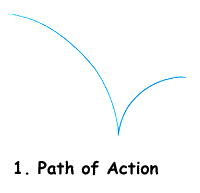 |
STEP 2 |
| Next we will plan the timing of the ball along our path of action. Draw tick marks. This will help us figure out the positions (on the arc) of the ball and the timing of the bounce. Tick marks at the beginning (the top of the arc) are close together; as the ball heads down, the tick marks become further and further apart. |  |
The action at the beginning of an arc is called a "slo-in". Once the ball hits - it looses a little momentum and then slows down (slo-out) as it approaches the top of the next arc.
TIP: Think of a ball rolling down a hill. It gains speed. Now we have created a guide for our timing.
STEP 3 |
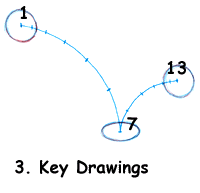 | 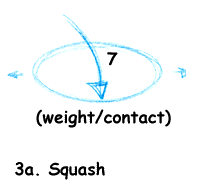 |
We "ruff" in our key drawings. Key drawings (or key poses) are at the beginning and at the end, and wherever the character, object, etc. changes direction. Our key drawings are #1, #7, and #13.
NOTE: Drawing #7 is where the ball makes contact, or impacts with the ground. #7 is the "squash" drawing, i.e., where we show the illusion of weight or impact of the object (3a).
TIP: The illusion of weight is very important. To maintain the integrity of the ball, be sure to maintain the same volume in drawing #7 (even though it is "squashed") as you have in drawings #1 and 13. Also, the faster the object, character, etc. moves, the more "squash" you have when it hits.
STEP 4 |
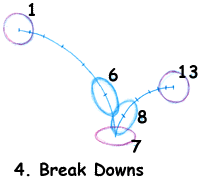 | 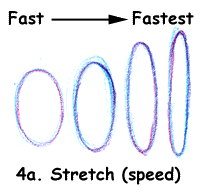 |
Next we add the breakdown drawings (#6 and #8). "Breakdowns" are really inbetween drawings which help describe the action. These drawings (known as "inbetweens" or "tweens") are the drawings between the pose or key drawings. In the hiarchy of animation, first you do the key drawings (or keys), next the breakdowns, and finally any further inbetween drawings needed to smooth out the action. The breakdowns for the bouncing ball show the illusion of speed. These are the "stretch" drawings. The stretch(speed) and squash(weight) drawings are relative to each other. Generally, if you have a lot of squash, you have a lot of stretch, too.
TIP: Notice that the ball goes from stretch directly to squash and back to stretch (# 6, #7, #8) with no "transition drawings". This gives snap to the ball's bounce.
STEP 5 |
| Finally, we draw in the rest of the inbetweens - #2 to #5; and #9 to #12. Notice that as the ball falls, the shape "transitions" from a round ball to more and more of an eliptical or stretched shape. | 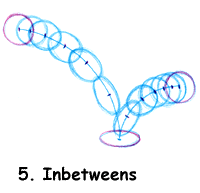 |
As the ball bounces up, it "transitions" from the stretched shape back to the round shape. There you have it -- the plan for a bouncing ball. Of course, each individual drawing would be placed on a separate piece of animation bond (paper).
Tuesday, February 25, 2014
Thursday, February 13, 2014
Wednesday, February 12, 2014
Tuesday, February 11, 2014
Monday, February 10, 2014
Sunday, February 9, 2014
"Whatever you do don't be bored."
http://www.youtube.com/watch?v=9yJE1iiO0qI&list=PLKNUS-mq3KUepgdj6QxqRKTF0Ar8wxHLk
My favorite animated film is Waking Life. It is about dreams and dreaming. They primarily made it using a technique called rotoscoping. It was written and directed by Richard Linklater.
Please follow the hypertext for more info.
My favorite animated film is Waking Life. It is about dreams and dreaming. They primarily made it using a technique called rotoscoping. It was written and directed by Richard Linklater.
Please follow the hypertext for more info.
Monday, February 3, 2014
Subscribe to:
Posts (Atom)









